The Aero Boero AB-210 is an Argentine civil utility aircraft, a development of the AB-180 with improved performance delivered by a fuel-injected engine. Unlike previous aircraft by this manufacturer, it also featured tricycle undercarriage, but retained the same general high-wing configuration. Only a single prototype was built, first flying on 22 April 1971.

The Lancair IV and IV-P are a family of four-seat, low-wing, retractable-gear, composite monoplanes powered by a 550 cubic inch Continental TSIO-550 twin-turbocharged piston engine.

The Lancair ES is an American amateur-built aircraft that was designed and produced by Lancair. While it was in production the aircraft was supplied as a kit for amateur construction.

The Lancair Legacy, a modernized version of the Lancair 320, is a low-wing two-place retractable-gear composite monoplane, manufactured by the US company Lancair. It is available as a kit that cost US$71,500 in 2011. There is also a fixed-gear version, the Legacy FG. The retractable version of the Legacy cruises at 276 mph at 8,000 ft and the fixed gear version cruises at 215 mph.
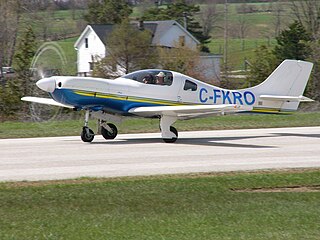
The Lancair 320 is a two-seat single-engined light aircraft marketed in kit form by the U.S. general aviation manufacturer Lancair. It is based on the Lancair 235, but with a larger fuselage and more powerful engine, and like the 235, it is a low-winged monoplane of composite construction with a retractable tricycle undercarriage, with side-by-side seating in an enclosed cockpit. The Lancair 360 is similar, but with a more powerful engine.
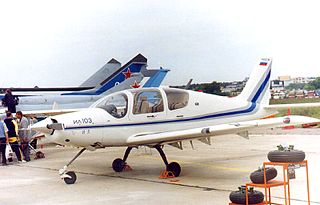
The Ilyushin Il-103 is a single-engine, low-wing training aircraft developed by the Ilyushin Design Bureau that started in 1990 in the Soviet Union. The aircraft is now produced in Russia. It was the first Russian aircraft to achieve Federal Aviation Administration certification, in 1998, for sales in the United States.
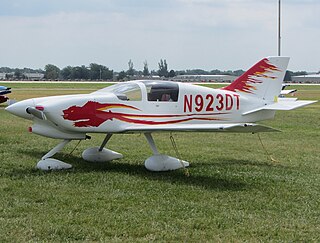
The Team Tango Tango 2 is an American low-wing composite homebuilt aircraft, marketed as a kit for amateur construction by Team Tango of Williston, Florida.

The KIS TR-4 Cruiser is a four place composite homebuilt aircraft design.
The Lucas L8, also called the L 8 and L-8, is a French amateur-built aircraft that was designed by Emile Lucas of Lagny-le-Sec. The aircraft is supplied in the form of plans for amateur construction.
The Peña Bilouis is a French aerobatic amateur-built aircraft that was designed by the competitive aerobatic pilot Louis Peña of Dax, Landes and made available in the form of plans for amateur construction.
The Peña Dahu, named for the legendary French mountain animal, is a French amateur-built aircraft that was designed by Louis Peña of Dax, Landes and made available in the form of plans for amateur construction.
The Adventure Air Adventurer is a family of American homebuilt amphibious flying boats that was designed and produced by Adventure Air of Berryville, Arkansas. When it was available the aircraft was supplied as a kit for amateur construction. The company appears to be out of business.

The Aircraft Technologies Acro 1 is an American aerobatic homebuilt aircraft that was designed by Fred Meyer and produced by Aircraft Technologies of Lilburn, Georgia. When it was available the aircraft was supplied as a kit or in the form of plans for amateur construction. Neither plans nor kits are available anymore and the aircraft is out of production.
The CEI Free Spirit Mk II, also called the Cabrinha Free Spirit Mark II and the Cabrinha Model 423, is a three-seat American homebuilt aircraft that was designed by Richard Cabrinha and produced by CEI of Auburn, California, introduced at AirVenture in 1995. The aircraft was intended to be supplied as a kit for amateur construction, but only prototypes seem to have been completed.
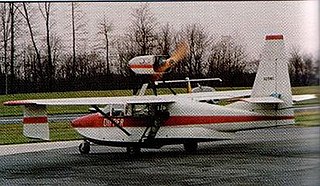
The Collins Dipper was an American homebuilt flying boat that was designed and produced by Collins Aero of Chadds Ford, Pennsylvania and first flown in 1982. The aircraft was supplied in the form of plans for amateur construction. Only one was built and none remain registered.
The Express Series 90 is an American homebuilt aircraft that was designed and produced by the Express Aircraft Company of Olympia, Washington, introduced in the late 1980s. When it was available the aircraft was supplied as a kit for amateur construction.
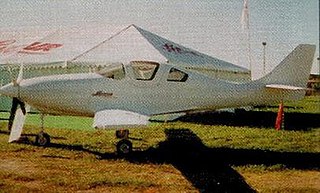
The Lancair Tigress was an American homebuilt aircraft that was designed by Lance Neibauer and intended for production by Lancair of Redmond, Oregon. Introduced in mid-late 1990s, it was essentially a Lancair IV with a much more powerful engine. When the engine was cancelled just as it was entering production, the Tigress project ended with it. Only prototypes were produced.
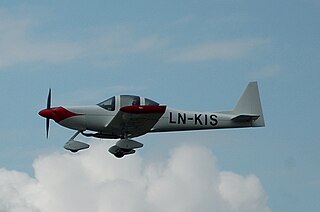
The Tri-R KIS TR-1 is an American homebuilt aircraft that was designed by Rich Trickel and produced by Tri-R Technologies of Oxnard, California, introduced in the 1990s. When it was available the aircraft was supplied as a kit for amateur construction.

The Brutsche Freedom 210 STOL was a proposed American STOL homebuilt aircraft that was designed by Neal H. Brutsche and intended to be produced by Brutsche Aircraft Corporation of Salt Lake City, Utah, introduced in the mid-1990s. The aircraft was planned to be supplied as a kit for amateur construction.
The Wega 180 is a Brazilian amateur-built aircraft designed and produced by Wega Industria Aeronautica of Palhoça, Santa Catarina, introduced at the Sun 'n Fun airshow in 2013. The aircraft is supplied as a kit for amateur construction or as a complete ready-to-fly-aircraft.














